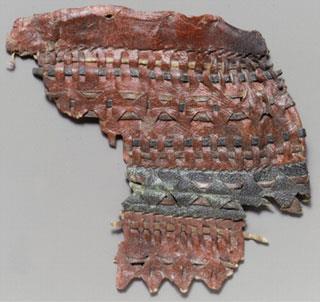Surface-enhanced Raman spectroscopy is allowing art conservators to rewrite sections of art history, reports Rajendrani Mukhopadhyay
Surface-enhanced Raman spectroscopy is allowing art conservators to rewrite sections of art history, reports Rajendrani Mukhopadhyay
Our favourite works of art shouldn’t always be taken at face value. Take, for example, Winslow Homer’s famous watercolour, For to be a farmer’s boy (right). The painting had long perplexed gallery-goers who couldn’t understand why the boy depicted appears to be standing in a sunset and yet the sky is pale. It took Raman spectroscopy to reveal the truth - the painting had originally shown a vivid sunset (see Chemistry World, May 2007, p12). In fact, Raman spectroscopy is allowing art conservators to unearth all sorts of secrets hidden in artworks and national treasures.

Art conservators have long been armed with analytical techniques to explore the chemical make-up of paints and dyes but in the past five years a method called surface-enhanced Raman spectroscopy (SERS) has started to attract their attention. Experts predict that in the next five years it will become an established part of the art world’s analytical toolbox.
Conservators routinely use chromatography, spectroscopy, and microscopy; each technique has obvious advantages and disadvantages. For example, high-performance liquid chromatography (HPLC) provides detailed information about the pigments and other components in dyes and paints but needs relatively large quantities of sample and laborious pre-treatment methods. With fragile and unique works of art, investigators don’t have the luxury of taking large samples. Ultraviolet-visible absorption and fluorescence spectroscopy are alternatives, but they lack the necessary specificity to pinpoint chemical signatures.
Raman’s roots
Raman spectroscopy, named after the Nobel laureate Sir Chandrasekhara Venkata Raman who discovered the effect, is a technique based on inelastic scattering of laser light that gives information about the vibrational, rotational, and other low-frequency modes of a molecular system. It has proved useful in analysing inorganic pigments in works of art and cultural heritage because it is non-destructive and doesn’t require sampling.
Raman’s enemy is fluorescence, explains Francesca Casadio, a conservation scientist at the Art Institute of Chicago, US. When Raman spectroscopy works, ’you get a nice spectrum with sharp bands’, she says. But when fluorescence appears, it ’obscures all the sharp bands under a hilly-looking background’.
Unfortunately, most natural organic pigments such as anthraquinones (reds), and flavonoids (yellows) are usually fluorescent. Organic indigo dyes can be detected by standard Raman spectroscopy but it doesn’t work for anthraquinones and flavonoids. For these, SERS is recommended because the surface-enhanced technique overcomes the two big disadvantages of conventional Raman: low sensitivity and competition with fluorescence, explains Concepci?n Domingo, a Raman spectroscopy expert at the Spanish National Research Council. She and others have shown that anthraquinones and flavonoids can be readily detected by SERS.
SERS at work
In Raman spectroscopy, photons from the laser interact with molecules and are scattered. Most photons are elastically scattered so that the emitted photons have the same wavelength and intensity as the absorbing photons. But about one in 100 of the incident photons are inelastically scattered so their wavelengths and intensities are shifted. The spectrum of wavelength shifted light is called the Raman spectrum and each line in the spectrum corresponds to a specific vibrational mode of the chemical bonds in a molecule. Each molecule has a unique Raman spectrum.

SERS, developed in the 1970s, boosts the Raman phenomenon. Its high sensitivity lets it detect vanishingly small amounts of natural organic pigments which had long eluded analysis by other approaches. At the heart of the technique lie metal nanoparticles - typically silver, copper or gold - ranging in size from 10 to 100nm. These are applied to the subject being analysed either as colloids or using films produced by electrochemical ’roughening’.
Molecules with conjugated aromatic rings and delocalised electron systems, such as anthraquinones and flavonoids, are attracted to the metal nanoparticles.
When hit by laser light, the nanostructures concentrate the electromagnetic field at their surface. This concentrated electromagnetic field amplifies the Raman signal of the molecules being studied. This Raman signal is then further amplified by a surface effect, raising the sensitivity of the technique over that of conventional Raman spectroscopy.
Surface sister
SERS has a sister technique called surface-enhanced resonance Raman spectroscopy (SERRS). In SERRS, the laser light is absorbed by the analyte, which doesn’t happen in SERS, explains Richard Van Duyne of Northwestern University, Evanston, US. Depending on the type of analyte, SERRS is 1000-1000,000 times more sensitive than SERS.
Invisible silver
It is fast becoming obvious to experts that there isn’t a one size fits all approach to applying silver colloid to works of art. The simplest method is to paint it on with a brush. Marco Leona, a conservation scientist at the Metropolitan Museum of Art in New York City, US, describes another technique called matrix transfer. A polymer gel is loaded with ethylenediaminetetraacetic acid (EDTA) and other solvent mixtures and a small bead of the gel - approximately 1mm in diameter - is then pressed onto the art object. The bead ’extracts a small amount of the dye present in the fibre or in the paint into the gel’, explains Leona. ’It’s such a mild extraction technique that it can be stopped before there is any fading or visible alteration of the art work.’ The gel, now carrying a sample of the dye or paint, can then be analysed by SERS.

Alternatively, Leona has come up with a system based on inkjet technology that places tiny drops of colloid in a reproducible manner on an object of interest. The drops of colloid are analysed under a Raman microscope as they get deposited. ’The advantage is that you are truly not removing anything,’ says Leona. Although silver is being added to the work of art, the amount is so miniscule that the colloid droplets are invisible to the eye after analysis, he says. Leona is currently turning the technology into a commercial product.
No matter how efficient sample handling techniques are, they can be rendered useless if they involve manipulation of the artwork. Despite the great sensitivity of the method, ’the main technical drawback with SERS and SERRS in art analysis is that it requires the sample to come into contact with a SERS active substrate,’ says Robert Withnall, a Raman spectroscopy expert at Brunel University, UK. ’It doesn’t lend the technique for use in many galleries and museums where a blanket policy is adopted of only allowing the artworks to be analysed both non-destructively and in situ.’
Insight into art
Nevertheless, in the past three years, art and cultural heritage works have been analysed by SERS, among them tapestries, paintings and sketches. Getting samples from textiles isn’t generally difficult because weavers often leave loose threads behind them, which provide plenty of sample for investigators, points out Leona. It’s the paintings, prints, and drawings that pose the challenge because they are damaged if too much sample is removed.
But recent efforts are proving that SERS can tackle such works of art. Earlier this year, Casadio and Van Duyne’s teams studied samples taken from Sketch of Margaret Sloane, looking right by the American painter Mary Cassatt and from several of her pastel sticks. They identified a broad range of natural and synthetic colourants and organic pigments: polyphenols, rhodamines, azo pigments and anthraquinones.
Around the same time, Leona showed that SERS could be applied to a 4000-year-old fragment of an Egyptian painted quiver (right). He discovered that the red translucent dye on the quiver belonged to madder, an organic plant pigment. The presence of madder-based pigment in such an ancient object is the first evidence of humans having sufficient chemical knowledge to extract a compound from a plant source and precipitate it into a solid pigment. Leona’s discovery also pushes back the date previously thought to be the first evidence for madder in Egypt by at least 700 years.

In analysing St John the Baptist bearing witness, Leona established that the main red pigment in Europe during the Renaissance came from an insect dye called kermes. The analysis also demonstrated for the first time that SERRS could detect dyes in glazes of oil paintings.
According to commercial records, lac, another insect dye, was thought to have reached Europe from south Asia by 1222. But its use in European art was not documented until the 15th century. Leona examined microscopic samples from the polychrome wood sculpture, Virgin and child in majesty , dated around 1150-1200 (see cover image), which is decorated with red glazes over inorganic red pigment layers to produce different shades of red, and found it to contain lac. The analysis confirms the dye’s trade between Europeans and Asians in the Middle Ages.
The findings, Leona explains, demonstrate how SERS can potentially change the understanding of human history. In the case of the quiver, the technique didn’t simply allow the analysis ’to be done a little bit better or a little bit faster’, he says. ’It was really a difference between being able to do it and not being able to do it.’
SERS is also shifting the way people view works of art, as a group led by Van Duyne and Casadio showed with the Homer’s For to be a farmer’s boy.
The discrepancy in colours between the boy’s face and the sky had perplexed art experts. ’The hypothesis was that the materials Homer used were light-sensitive and they faded over time,’ says Van Duyne. ’One of the art conservators had examined the painting with standard optical microscopy and occasionally saw a bright orange flash of colour from particles that were hypothesised not to have been photochemically altered.’
Then the research team studied a fragment from a 10 m m diameter particle that seemed to be unaltered from the painting. ’We were able to identify what we think is the original pigment,’ says Van Duyne.
With the data, experts at the Art Institute in Chicago have now digitally reconstructed the painting with a vivid, sunset orange sky to suggest what the original may have looked like.
SERS setbacks
None of the experts claim that SERS will be the only way to tackle organic pigment analysis in the future but they hope it will become an integral part of the analytical toolbox.
The technique is still in its infancy in the art world and has yet to prove that it can tackle more difficult subjects such as oil paintings - where the minute quantities of organic materials are drenched in an oil binder and other substances which can interfere with the interactions between the silver nanoparticles and the organic molecules.
Besides technical drawbacks with SERS, there are also some practical hurdles. ’The biggest limitation is having access to a laboratory with the instrumentation that is willing to dedicate the time,’ says Cecily Grzywacz, a scientist at the Getty Conservation Institute in Los Angeles, US.
Libraries of spectra are another issue with SERS for art. Just as in Raman spectroscopy, the spectra obtained by SERS have to be compared with a database of reference spectra to match the peaks to a given chemical. But databases of SERS spectra for artist materials are very limited. ’As with any analytical chemistry, you need standards,’ states Grzywacz. ’Unfortunately, with historical materials, you can’t buy these standards.’
Conventional Raman spectroscopy is a more mature technique in the art analysis field so there are databases available to researchers (as found at the Infrared and Raman Users Group,
www.irug.org). But SERS spectra can’t be searched against the existing Raman libraries. In SERS, ’you have a number of enhancement effects happening at the same time,’ explains Casadio. ’Bands shift slightly in wavenumber and in the ratio of intensities. You can’t easily translate Raman databases into SERS databases.’
SERS databases have to be painstakingly created to be made as comprehensive and accessible as current Raman databases. While comparing spectra to a database is the standard approach, Van Duyne says there is a way around it. ’There are quantum mechanics programmes that actually allow you to calculate the Raman spectrum. They are so good that you can basically identify the molecules by guessing a structure and comparing a calculated spectrum with the experimentally collected one,’ he says. However, the quantum mechanics programmes are state of the art and require expertise to run, he adds.
Experts in art conservation not directly involved with SERS also say that the method is only useful if a lab has enough expertise and experience. ’This is still a technique that requires a spectroscopist who has a lot of experience with SERS,’ says Barbara Berrie at the scientific research department of the National Gallery of Art in Washington DC, US. ’For an art historian or a conservator who has a question about the pigments and dyes in a work of art, this is an ideal opportunity for collaboration.’
Art conservators and SERS investigators are working to encourage partnerships across the divide of science and art. They see it as being worth their while to put in the time and effort to develop SERS into a mature, established technique in the field. As Casadio puts it, the method ’could allow parts of art history to be rewritten’.
Rajendrani Mukhopadhyay is a freelance science journalist based in Washington DC, US
Further Reading
M V Ca?amares et al, Vib. Spectrosc., 2006, 40, 161
Z Jurasekova et al, J. Raman Spectrosc., 2006, 37, 1239
M Leona and J R Lombardi, J. Raman Spectrosc ., 2007, 38, 853
C L Brosseau et al, Anal. Chem., 2009, 81, 3056
C L Brosseau et al, Anal. Chem., 2009, 81, 7443
M Leona, Proc. Natl. Acad. Sci. USA, 2009, 106, 14757






No comments yet